Analyzing Economic, Environmental & Socio-Cultural Impacts of Tourism
VerifiedAdded on 2023/06/18
|9
|2295
|136
Essay
AI Summary
This essay provides a comprehensive overview of the tourism industry, defining it as a combination of commercial businesses that facilitate leisure and business activities away from home. It discusses the development of contemporary tourism, highlighting significant factors like weather, landscape, historical and cultural elements, and technology. The essay identifies and analyzes the positive economic impacts of tourism, such as job creation and increased national income, as well as negative impacts like seasonal jobs and revenue leakage to large companies. Furthermore, it explores the environmental impacts, noting both the potential for conservation through tourism revenue and the risks of environmental damage from increased consumption and pollution. Finally, the essay examines the socio-cultural impacts, pointing out how tourism can help preserve local traditions but also lead to cultural modification and potential harm to existing cultures. The conclusion emphasizes tourism's crucial role in economic growth and the need for sustainable development practices.
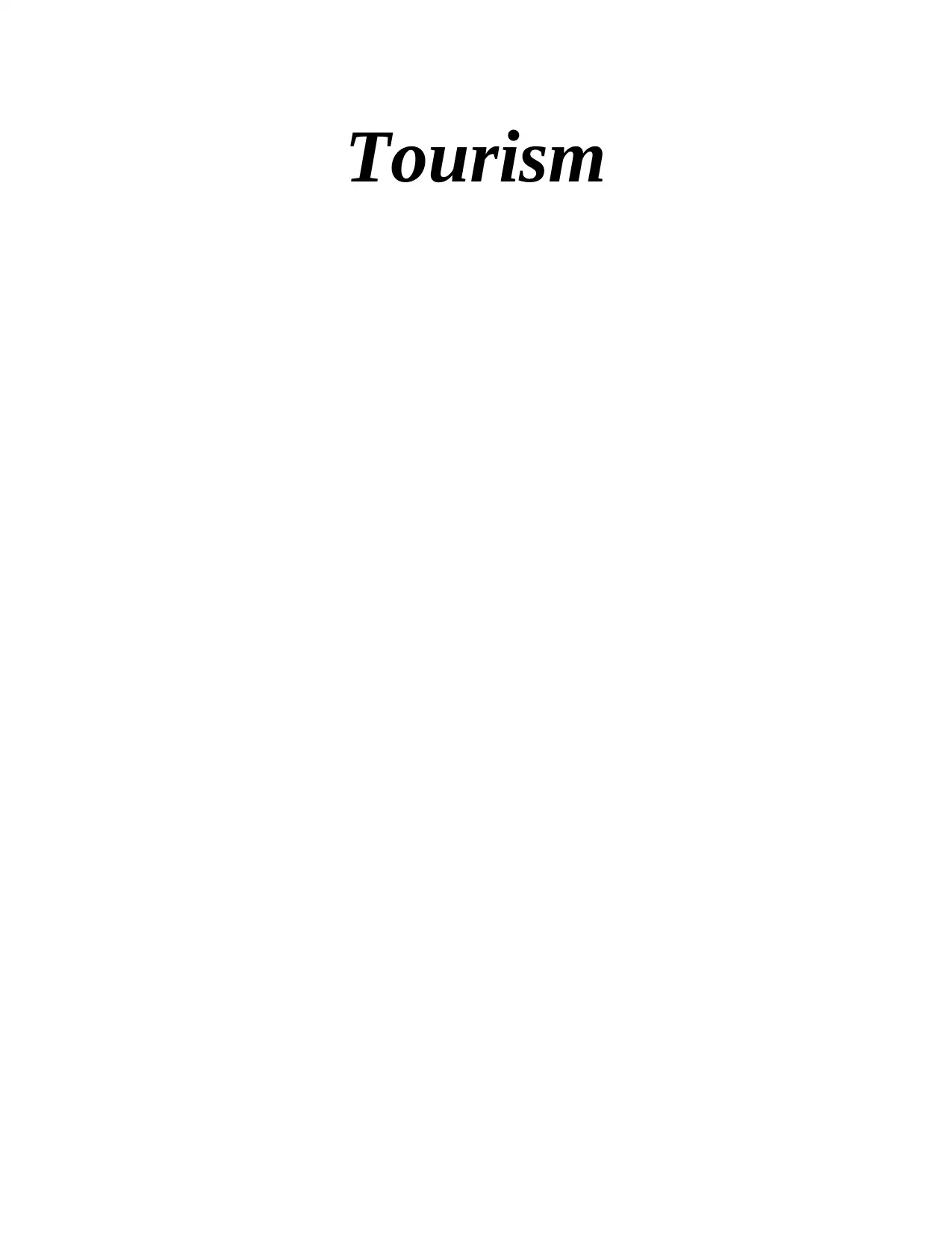
Tourism
Paraphrase This Document
Need a fresh take? Get an instant paraphrase of this document with our AI Paraphraser

Table of Contents
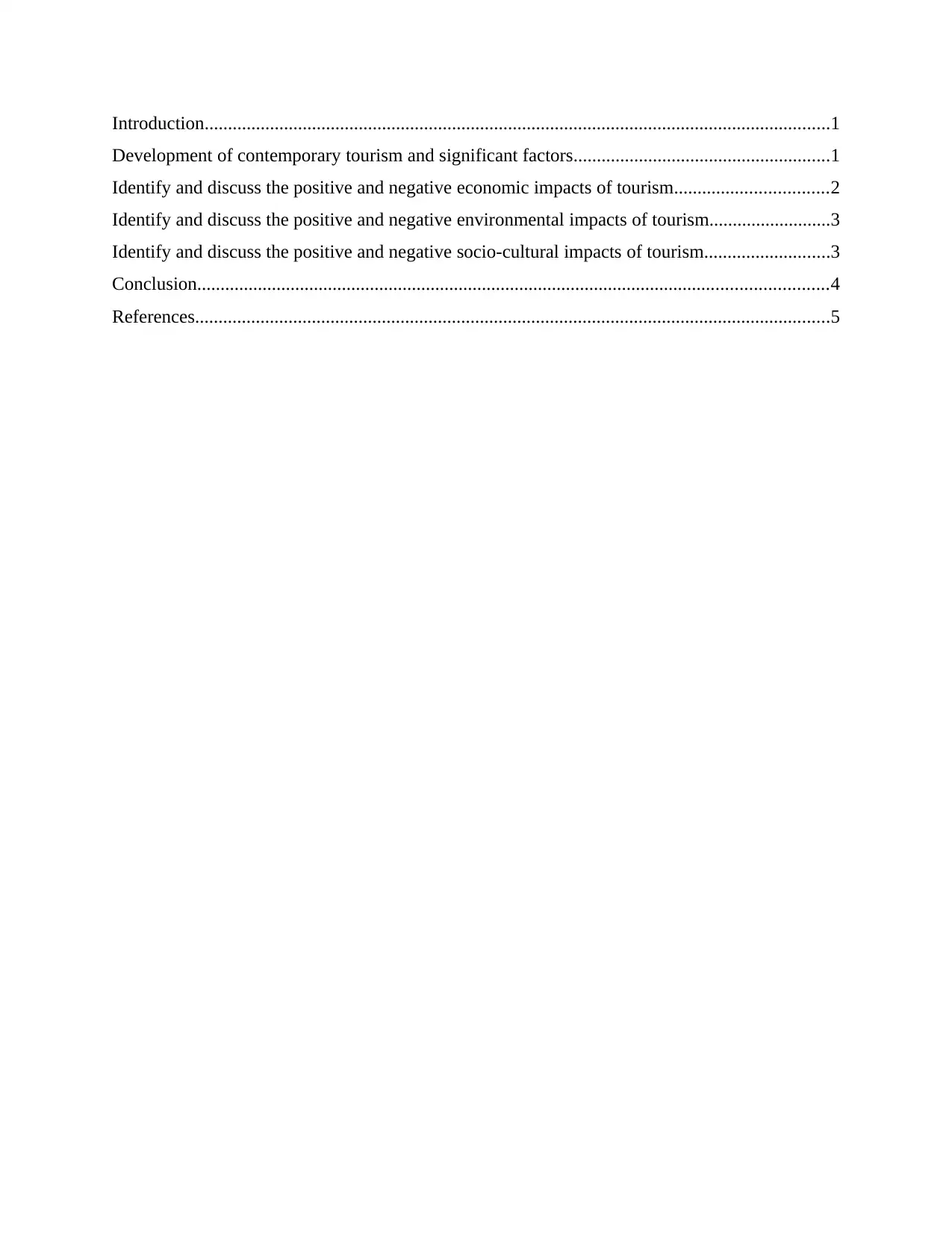
Introduction......................................................................................................................................1
Development of contemporary tourism and significant factors.......................................................1
Identify and discuss the positive and negative economic impacts of tourism.................................2
Identify and discuss the positive and negative environmental impacts of tourism..........................3
Identify and discuss the positive and negative socio-cultural impacts of tourism...........................3
Conclusion.......................................................................................................................................4
References........................................................................................................................................5
Development of contemporary tourism and significant factors.......................................................1
Identify and discuss the positive and negative economic impacts of tourism.................................2
Identify and discuss the positive and negative environmental impacts of tourism..........................3
Identify and discuss the positive and negative socio-cultural impacts of tourism...........................3
Conclusion.......................................................................................................................................4
References........................................................................................................................................5
⊘ This is a preview!⊘
Do you want full access?
Subscribe today to unlock all pages.

Trusted by 1+ million students worldwide

Paraphrase This Document
Need a fresh take? Get an instant paraphrase of this document with our AI Paraphraser
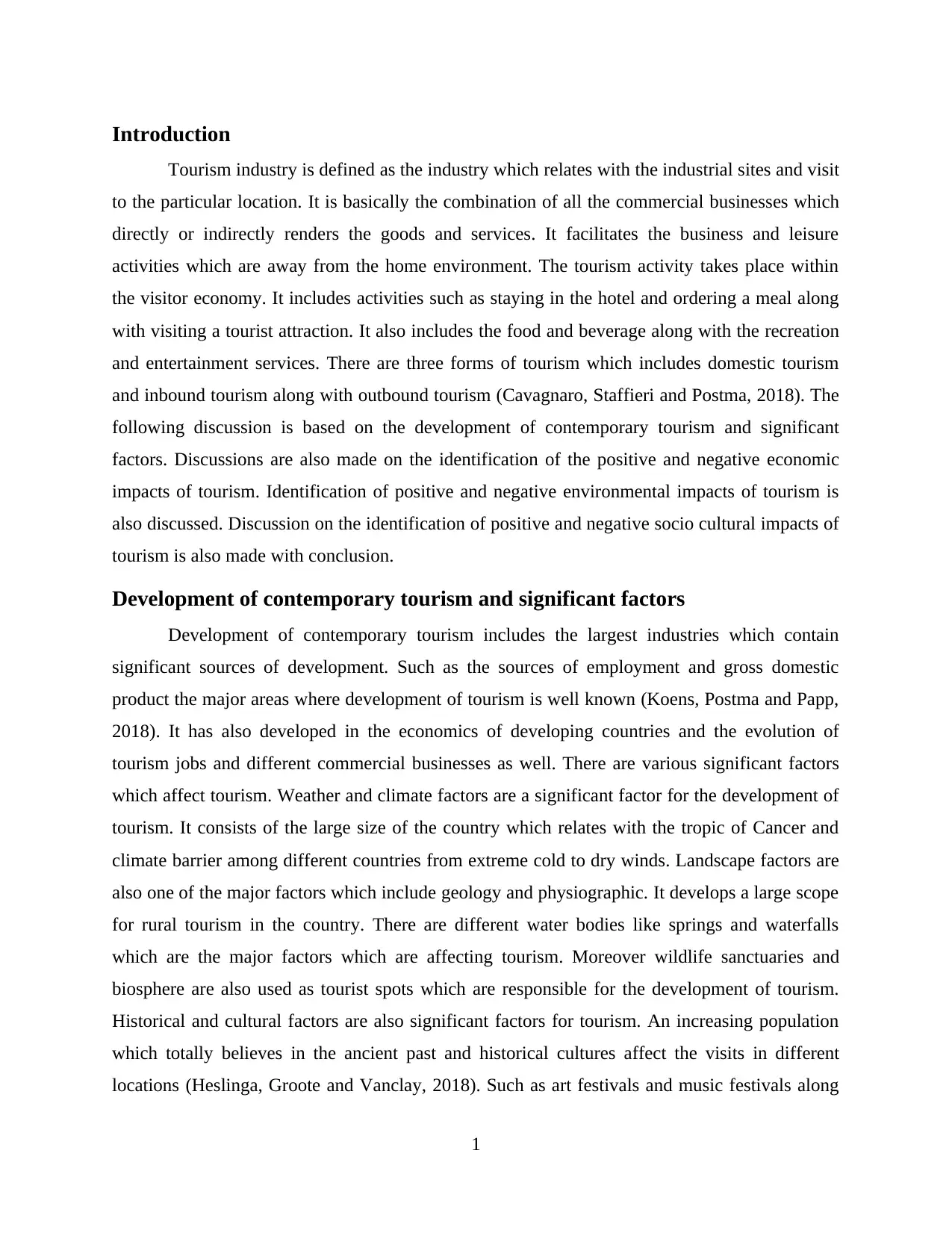
Introduction
Tourism industry is defined as the industry which relates with the industrial sites and visit
to the particular location. It is basically the combination of all the commercial businesses which
directly or indirectly renders the goods and services. It facilitates the business and leisure
activities which are away from the home environment. The tourism activity takes place within
the visitor economy. It includes activities such as staying in the hotel and ordering a meal along
with visiting a tourist attraction. It also includes the food and beverage along with the recreation
and entertainment services. There are three forms of tourism which includes domestic tourism
and inbound tourism along with outbound tourism (Cavagnaro, Staffieri and Postma, 2018). The
following discussion is based on the development of contemporary tourism and significant
factors. Discussions are also made on the identification of the positive and negative economic
impacts of tourism. Identification of positive and negative environmental impacts of tourism is
also discussed. Discussion on the identification of positive and negative socio cultural impacts of
tourism is also made with conclusion.
Development of contemporary tourism and significant factors
Development of contemporary tourism includes the largest industries which contain
significant sources of development. Such as the sources of employment and gross domestic
product the major areas where development of tourism is well known (Koens, Postma and Papp,
2018). It has also developed in the economics of developing countries and the evolution of
tourism jobs and different commercial businesses as well. There are various significant factors
which affect tourism. Weather and climate factors are a significant factor for the development of
tourism. It consists of the large size of the country which relates with the tropic of Cancer and
climate barrier among different countries from extreme cold to dry winds. Landscape factors are
also one of the major factors which include geology and physiographic. It develops a large scope
for rural tourism in the country. There are different water bodies like springs and waterfalls
which are the major factors which are affecting tourism. Moreover wildlife sanctuaries and
biosphere are also used as tourist spots which are responsible for the development of tourism.
Historical and cultural factors are also significant factors for tourism. An increasing population
which totally believes in the ancient past and historical cultures affect the visits in different
locations (Heslinga, Groote and Vanclay, 2018). Such as art festivals and music festivals along
1
Tourism industry is defined as the industry which relates with the industrial sites and visit
to the particular location. It is basically the combination of all the commercial businesses which
directly or indirectly renders the goods and services. It facilitates the business and leisure
activities which are away from the home environment. The tourism activity takes place within
the visitor economy. It includes activities such as staying in the hotel and ordering a meal along
with visiting a tourist attraction. It also includes the food and beverage along with the recreation
and entertainment services. There are three forms of tourism which includes domestic tourism
and inbound tourism along with outbound tourism (Cavagnaro, Staffieri and Postma, 2018). The
following discussion is based on the development of contemporary tourism and significant
factors. Discussions are also made on the identification of the positive and negative economic
impacts of tourism. Identification of positive and negative environmental impacts of tourism is
also discussed. Discussion on the identification of positive and negative socio cultural impacts of
tourism is also made with conclusion.
Development of contemporary tourism and significant factors
Development of contemporary tourism includes the largest industries which contain
significant sources of development. Such as the sources of employment and gross domestic
product the major areas where development of tourism is well known (Koens, Postma and Papp,
2018). It has also developed in the economics of developing countries and the evolution of
tourism jobs and different commercial businesses as well. There are various significant factors
which affect tourism. Weather and climate factors are a significant factor for the development of
tourism. It consists of the large size of the country which relates with the tropic of Cancer and
climate barrier among different countries from extreme cold to dry winds. Landscape factors are
also one of the major factors which include geology and physiographic. It develops a large scope
for rural tourism in the country. There are different water bodies like springs and waterfalls
which are the major factors which are affecting tourism. Moreover wildlife sanctuaries and
biosphere are also used as tourist spots which are responsible for the development of tourism.
Historical and cultural factors are also significant factors for tourism. An increasing population
which totally believes in the ancient past and historical cultures affect the visits in different
locations (Heslinga, Groote and Vanclay, 2018). Such as art festivals and music festivals along
1
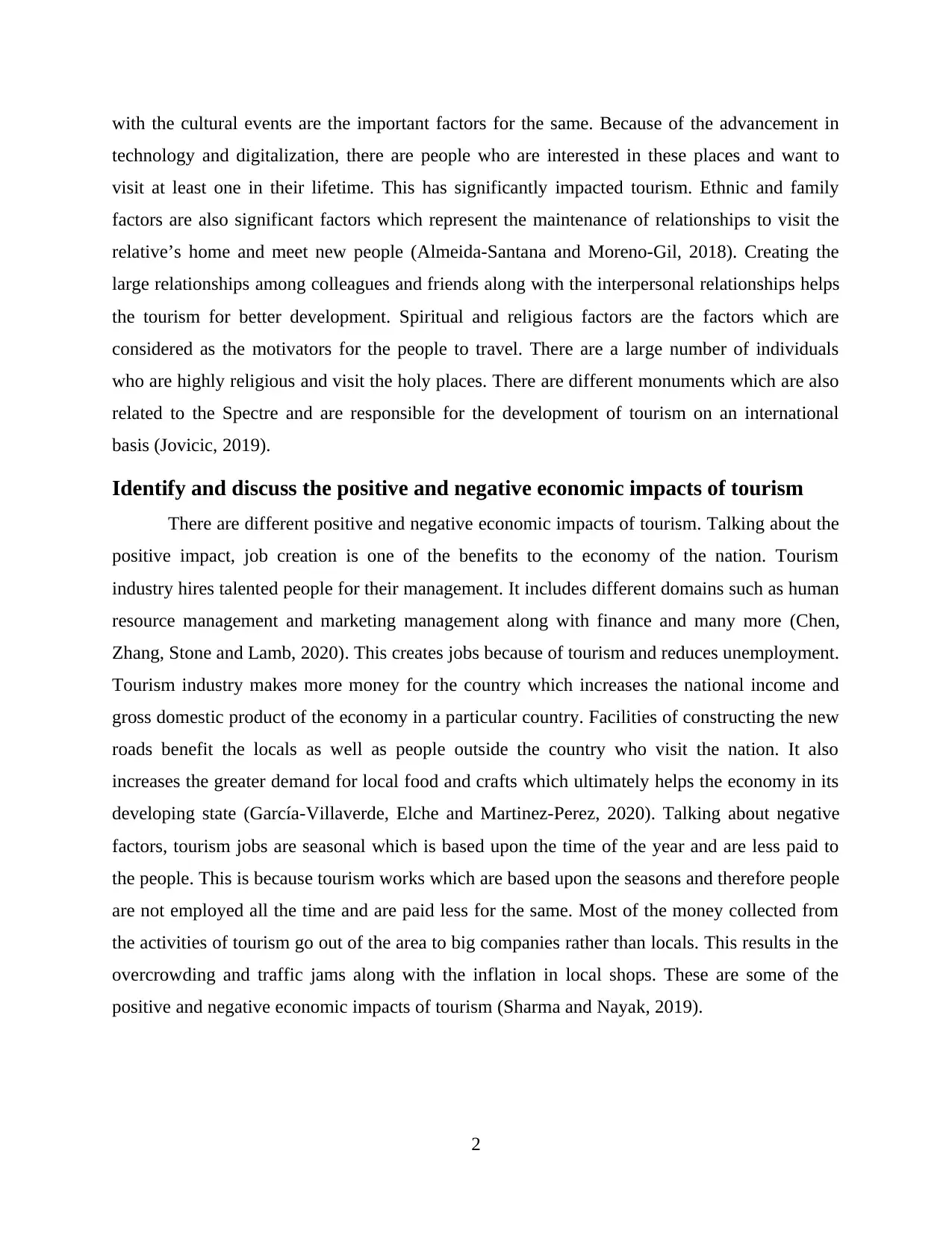
with the cultural events are the important factors for the same. Because of the advancement in
technology and digitalization, there are people who are interested in these places and want to
visit at least one in their lifetime. This has significantly impacted tourism. Ethnic and family
factors are also significant factors which represent the maintenance of relationships to visit the
relative’s home and meet new people (Almeida-Santana and Moreno-Gil, 2018). Creating the
large relationships among colleagues and friends along with the interpersonal relationships helps
the tourism for better development. Spiritual and religious factors are the factors which are
considered as the motivators for the people to travel. There are a large number of individuals
who are highly religious and visit the holy places. There are different monuments which are also
related to the Spectre and are responsible for the development of tourism on an international
basis (Jovicic, 2019).
Identify and discuss the positive and negative economic impacts of tourism
There are different positive and negative economic impacts of tourism. Talking about the
positive impact, job creation is one of the benefits to the economy of the nation. Tourism
industry hires talented people for their management. It includes different domains such as human
resource management and marketing management along with finance and many more (Chen,
Zhang, Stone and Lamb, 2020). This creates jobs because of tourism and reduces unemployment.
Tourism industry makes more money for the country which increases the national income and
gross domestic product of the economy in a particular country. Facilities of constructing the new
roads benefit the locals as well as people outside the country who visit the nation. It also
increases the greater demand for local food and crafts which ultimately helps the economy in its
developing state (García-Villaverde, Elche and Martinez-Perez, 2020). Talking about negative
factors, tourism jobs are seasonal which is based upon the time of the year and are less paid to
the people. This is because tourism works which are based upon the seasons and therefore people
are not employed all the time and are paid less for the same. Most of the money collected from
the activities of tourism go out of the area to big companies rather than locals. This results in the
overcrowding and traffic jams along with the inflation in local shops. These are some of the
positive and negative economic impacts of tourism (Sharma and Nayak, 2019).
2
technology and digitalization, there are people who are interested in these places and want to
visit at least one in their lifetime. This has significantly impacted tourism. Ethnic and family
factors are also significant factors which represent the maintenance of relationships to visit the
relative’s home and meet new people (Almeida-Santana and Moreno-Gil, 2018). Creating the
large relationships among colleagues and friends along with the interpersonal relationships helps
the tourism for better development. Spiritual and religious factors are the factors which are
considered as the motivators for the people to travel. There are a large number of individuals
who are highly religious and visit the holy places. There are different monuments which are also
related to the Spectre and are responsible for the development of tourism on an international
basis (Jovicic, 2019).
Identify and discuss the positive and negative economic impacts of tourism
There are different positive and negative economic impacts of tourism. Talking about the
positive impact, job creation is one of the benefits to the economy of the nation. Tourism
industry hires talented people for their management. It includes different domains such as human
resource management and marketing management along with finance and many more (Chen,
Zhang, Stone and Lamb, 2020). This creates jobs because of tourism and reduces unemployment.
Tourism industry makes more money for the country which increases the national income and
gross domestic product of the economy in a particular country. Facilities of constructing the new
roads benefit the locals as well as people outside the country who visit the nation. It also
increases the greater demand for local food and crafts which ultimately helps the economy in its
developing state (García-Villaverde, Elche and Martinez-Perez, 2020). Talking about negative
factors, tourism jobs are seasonal which is based upon the time of the year and are less paid to
the people. This is because tourism works which are based upon the seasons and therefore people
are not employed all the time and are paid less for the same. Most of the money collected from
the activities of tourism go out of the area to big companies rather than locals. This results in the
overcrowding and traffic jams along with the inflation in local shops. These are some of the
positive and negative economic impacts of tourism (Sharma and Nayak, 2019).
2
⊘ This is a preview!⊘
Do you want full access?
Subscribe today to unlock all pages.

Trusted by 1+ million students worldwide
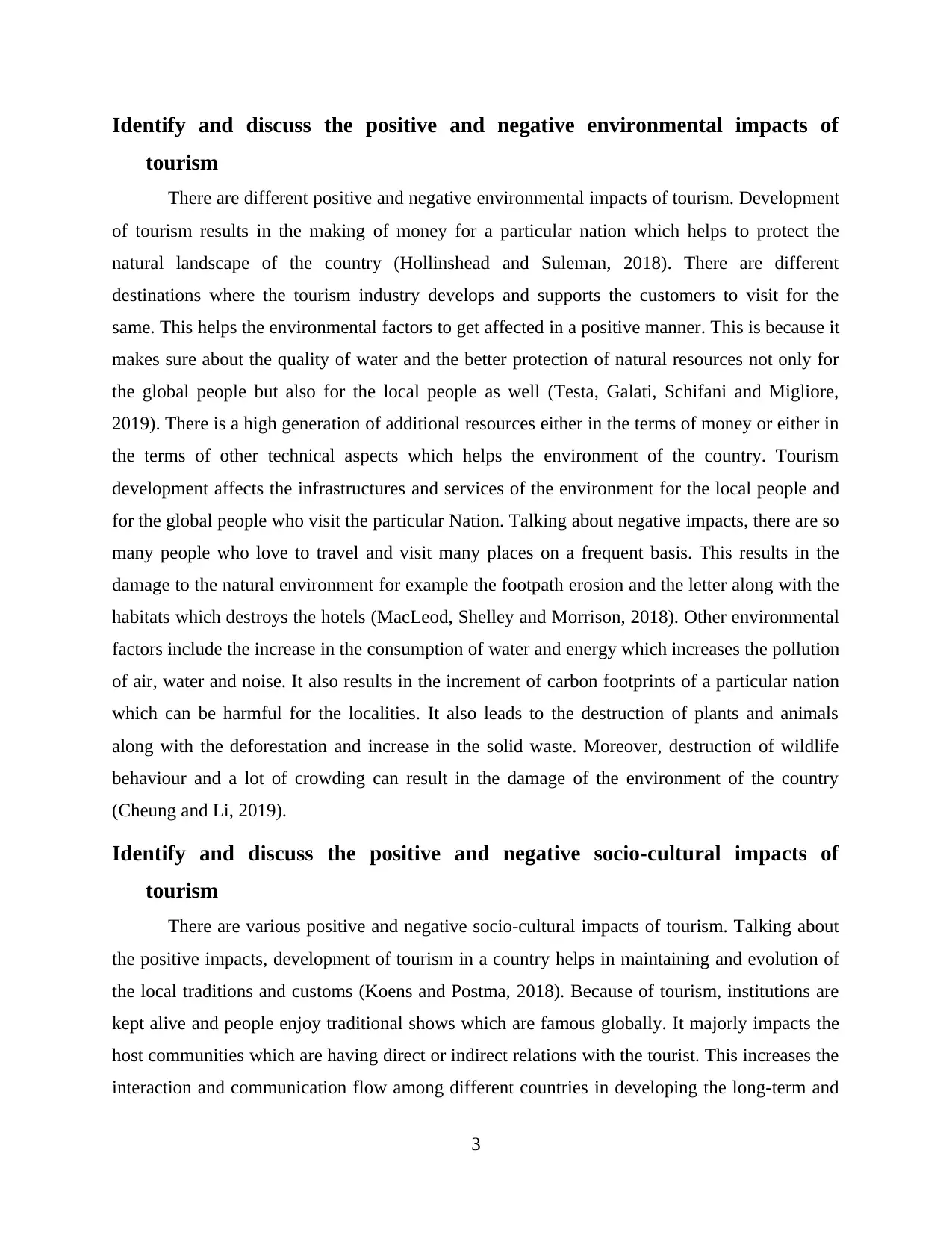
Identify and discuss the positive and negative environmental impacts of
tourism
There are different positive and negative environmental impacts of tourism. Development
of tourism results in the making of money for a particular nation which helps to protect the
natural landscape of the country (Hollinshead and Suleman, 2018). There are different
destinations where the tourism industry develops and supports the customers to visit for the
same. This helps the environmental factors to get affected in a positive manner. This is because it
makes sure about the quality of water and the better protection of natural resources not only for
the global people but also for the local people as well (Testa, Galati, Schifani and Migliore,
2019). There is a high generation of additional resources either in the terms of money or either in
the terms of other technical aspects which helps the environment of the country. Tourism
development affects the infrastructures and services of the environment for the local people and
for the global people who visit the particular Nation. Talking about negative impacts, there are so
many people who love to travel and visit many places on a frequent basis. This results in the
damage to the natural environment for example the footpath erosion and the letter along with the
habitats which destroys the hotels (MacLeod, Shelley and Morrison, 2018). Other environmental
factors include the increase in the consumption of water and energy which increases the pollution
of air, water and noise. It also results in the increment of carbon footprints of a particular nation
which can be harmful for the localities. It also leads to the destruction of plants and animals
along with the deforestation and increase in the solid waste. Moreover, destruction of wildlife
behaviour and a lot of crowding can result in the damage of the environment of the country
(Cheung and Li, 2019).
Identify and discuss the positive and negative socio-cultural impacts of
tourism
There are various positive and negative socio-cultural impacts of tourism. Talking about
the positive impacts, development of tourism in a country helps in maintaining and evolution of
the local traditions and customs (Koens and Postma, 2018). Because of tourism, institutions are
kept alive and people enjoy traditional shows which are famous globally. It majorly impacts the
host communities which are having direct or indirect relations with the tourist. This increases the
interaction and communication flow among different countries in developing the long-term and
3
tourism
There are different positive and negative environmental impacts of tourism. Development
of tourism results in the making of money for a particular nation which helps to protect the
natural landscape of the country (Hollinshead and Suleman, 2018). There are different
destinations where the tourism industry develops and supports the customers to visit for the
same. This helps the environmental factors to get affected in a positive manner. This is because it
makes sure about the quality of water and the better protection of natural resources not only for
the global people but also for the local people as well (Testa, Galati, Schifani and Migliore,
2019). There is a high generation of additional resources either in the terms of money or either in
the terms of other technical aspects which helps the environment of the country. Tourism
development affects the infrastructures and services of the environment for the local people and
for the global people who visit the particular Nation. Talking about negative impacts, there are so
many people who love to travel and visit many places on a frequent basis. This results in the
damage to the natural environment for example the footpath erosion and the letter along with the
habitats which destroys the hotels (MacLeod, Shelley and Morrison, 2018). Other environmental
factors include the increase in the consumption of water and energy which increases the pollution
of air, water and noise. It also results in the increment of carbon footprints of a particular nation
which can be harmful for the localities. It also leads to the destruction of plants and animals
along with the deforestation and increase in the solid waste. Moreover, destruction of wildlife
behaviour and a lot of crowding can result in the damage of the environment of the country
(Cheung and Li, 2019).
Identify and discuss the positive and negative socio-cultural impacts of
tourism
There are various positive and negative socio-cultural impacts of tourism. Talking about
the positive impacts, development of tourism in a country helps in maintaining and evolution of
the local traditions and customs (Koens and Postma, 2018). Because of tourism, institutions are
kept alive and people enjoy traditional shows which are famous globally. It majorly impacts the
host communities which are having direct or indirect relations with the tourist. This increases the
interaction and communication flow among different countries in developing the long-term and
3
Paraphrase This Document
Need a fresh take? Get an instant paraphrase of this document with our AI Paraphraser
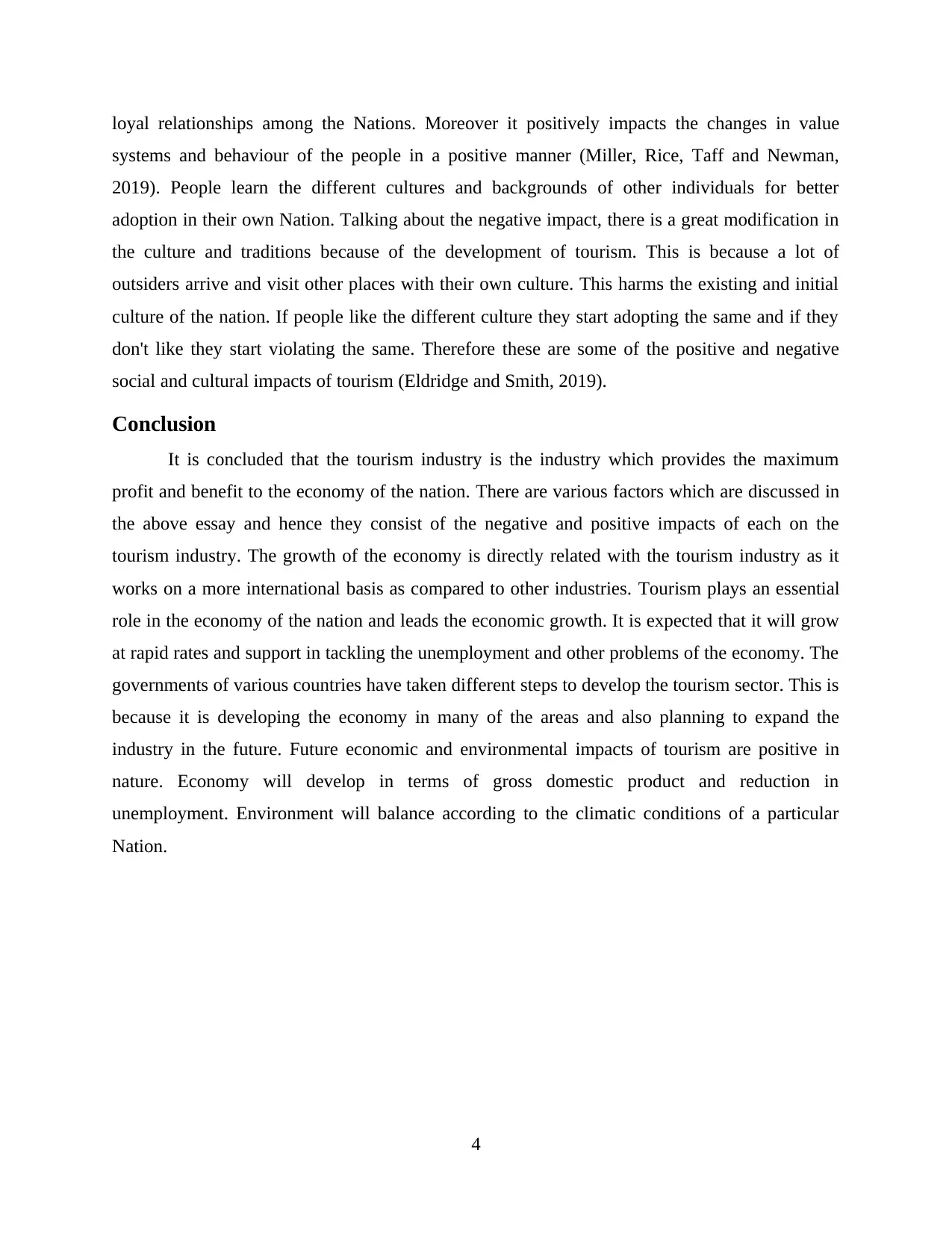
loyal relationships among the Nations. Moreover it positively impacts the changes in value
systems and behaviour of the people in a positive manner (Miller, Rice, Taff and Newman,
2019). People learn the different cultures and backgrounds of other individuals for better
adoption in their own Nation. Talking about the negative impact, there is a great modification in
the culture and traditions because of the development of tourism. This is because a lot of
outsiders arrive and visit other places with their own culture. This harms the existing and initial
culture of the nation. If people like the different culture they start adopting the same and if they
don't like they start violating the same. Therefore these are some of the positive and negative
social and cultural impacts of tourism (Eldridge and Smith, 2019).
Conclusion
It is concluded that the tourism industry is the industry which provides the maximum
profit and benefit to the economy of the nation. There are various factors which are discussed in
the above essay and hence they consist of the negative and positive impacts of each on the
tourism industry. The growth of the economy is directly related with the tourism industry as it
works on a more international basis as compared to other industries. Tourism plays an essential
role in the economy of the nation and leads the economic growth. It is expected that it will grow
at rapid rates and support in tackling the unemployment and other problems of the economy. The
governments of various countries have taken different steps to develop the tourism sector. This is
because it is developing the economy in many of the areas and also planning to expand the
industry in the future. Future economic and environmental impacts of tourism are positive in
nature. Economy will develop in terms of gross domestic product and reduction in
unemployment. Environment will balance according to the climatic conditions of a particular
Nation.
4
systems and behaviour of the people in a positive manner (Miller, Rice, Taff and Newman,
2019). People learn the different cultures and backgrounds of other individuals for better
adoption in their own Nation. Talking about the negative impact, there is a great modification in
the culture and traditions because of the development of tourism. This is because a lot of
outsiders arrive and visit other places with their own culture. This harms the existing and initial
culture of the nation. If people like the different culture they start adopting the same and if they
don't like they start violating the same. Therefore these are some of the positive and negative
social and cultural impacts of tourism (Eldridge and Smith, 2019).
Conclusion
It is concluded that the tourism industry is the industry which provides the maximum
profit and benefit to the economy of the nation. There are various factors which are discussed in
the above essay and hence they consist of the negative and positive impacts of each on the
tourism industry. The growth of the economy is directly related with the tourism industry as it
works on a more international basis as compared to other industries. Tourism plays an essential
role in the economy of the nation and leads the economic growth. It is expected that it will grow
at rapid rates and support in tackling the unemployment and other problems of the economy. The
governments of various countries have taken different steps to develop the tourism sector. This is
because it is developing the economy in many of the areas and also planning to expand the
industry in the future. Future economic and environmental impacts of tourism are positive in
nature. Economy will develop in terms of gross domestic product and reduction in
unemployment. Environment will balance according to the climatic conditions of a particular
Nation.
4
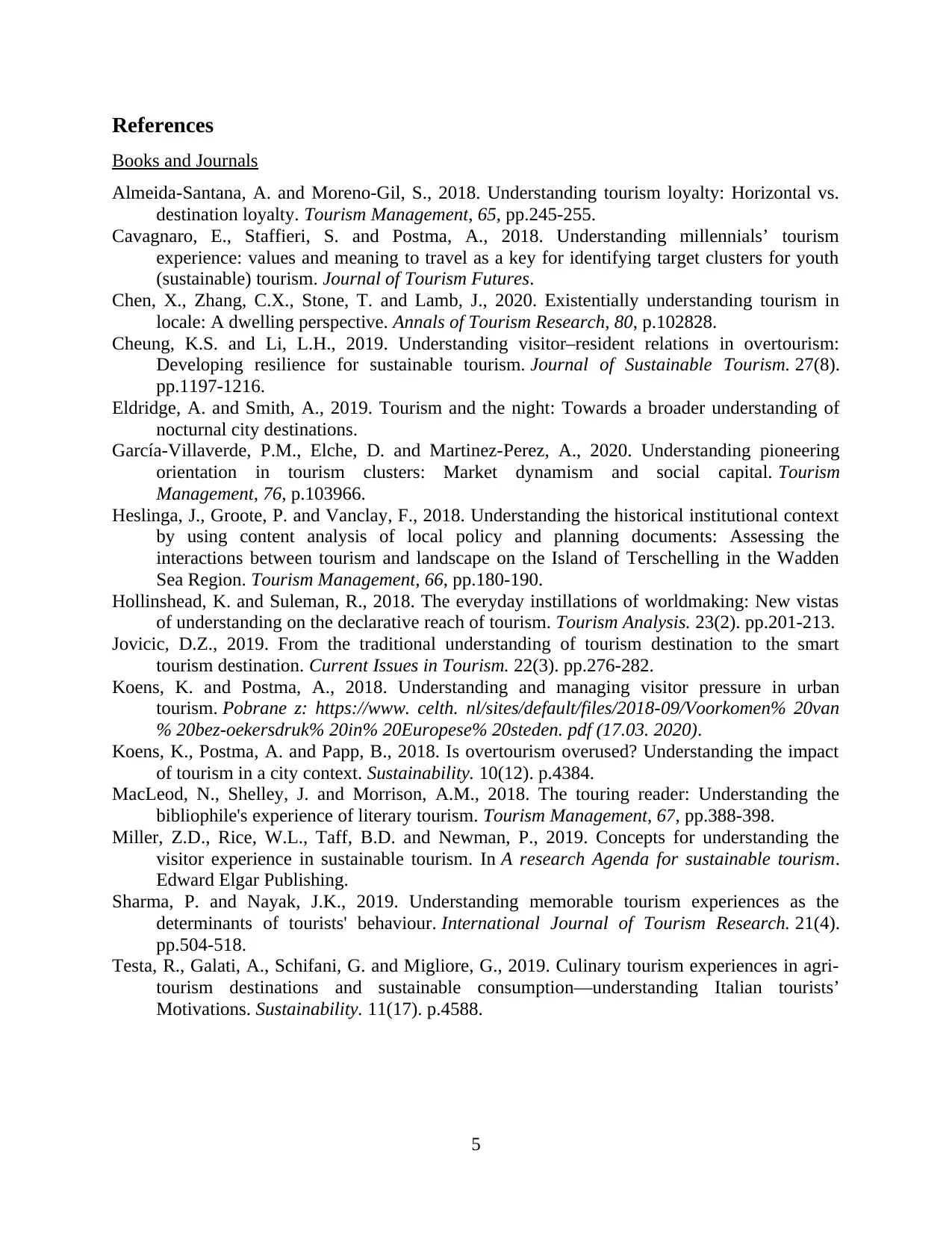
References
Books and Journals
Almeida-Santana, A. and Moreno-Gil, S., 2018. Understanding tourism loyalty: Horizontal vs.
destination loyalty. Tourism Management, 65, pp.245-255.
Cavagnaro, E., Staffieri, S. and Postma, A., 2018. Understanding millennials’ tourism
experience: values and meaning to travel as a key for identifying target clusters for youth
(sustainable) tourism. Journal of Tourism Futures.
Chen, X., Zhang, C.X., Stone, T. and Lamb, J., 2020. Existentially understanding tourism in
locale: A dwelling perspective. Annals of Tourism Research, 80, p.102828.
Cheung, K.S. and Li, L.H., 2019. Understanding visitor–resident relations in overtourism:
Developing resilience for sustainable tourism. Journal of Sustainable Tourism. 27(8).
pp.1197-1216.
Eldridge, A. and Smith, A., 2019. Tourism and the night: Towards a broader understanding of
nocturnal city destinations.
García-Villaverde, P.M., Elche, D. and Martinez-Perez, A., 2020. Understanding pioneering
orientation in tourism clusters: Market dynamism and social capital. Tourism
Management, 76, p.103966.
Heslinga, J., Groote, P. and Vanclay, F., 2018. Understanding the historical institutional context
by using content analysis of local policy and planning documents: Assessing the
interactions between tourism and landscape on the Island of Terschelling in the Wadden
Sea Region. Tourism Management, 66, pp.180-190.
Hollinshead, K. and Suleman, R., 2018. The everyday instillations of worldmaking: New vistas
of understanding on the declarative reach of tourism. Tourism Analysis. 23(2). pp.201-213.
Jovicic, D.Z., 2019. From the traditional understanding of tourism destination to the smart
tourism destination. Current Issues in Tourism. 22(3). pp.276-282.
Koens, K. and Postma, A., 2018. Understanding and managing visitor pressure in urban
tourism. Pobrane z: https://www. celth. nl/sites/default/files/2018-09/Voorkomen% 20van
% 20bez-oekersdruk% 20in% 20Europese% 20steden. pdf (17.03. 2020).
Koens, K., Postma, A. and Papp, B., 2018. Is overtourism overused? Understanding the impact
of tourism in a city context. Sustainability. 10(12). p.4384.
MacLeod, N., Shelley, J. and Morrison, A.M., 2018. The touring reader: Understanding the
bibliophile's experience of literary tourism. Tourism Management, 67, pp.388-398.
Miller, Z.D., Rice, W.L., Taff, B.D. and Newman, P., 2019. Concepts for understanding the
visitor experience in sustainable tourism. In A research Agenda for sustainable tourism.
Edward Elgar Publishing.
Sharma, P. and Nayak, J.K., 2019. Understanding memorable tourism experiences as the
determinants of tourists' behaviour. International Journal of Tourism Research. 21(4).
pp.504-518.
Testa, R., Galati, A., Schifani, G. and Migliore, G., 2019. Culinary tourism experiences in agri-
tourism destinations and sustainable consumption—understanding Italian tourists’
Motivations. Sustainability. 11(17). p.4588.
5
Books and Journals
Almeida-Santana, A. and Moreno-Gil, S., 2018. Understanding tourism loyalty: Horizontal vs.
destination loyalty. Tourism Management, 65, pp.245-255.
Cavagnaro, E., Staffieri, S. and Postma, A., 2018. Understanding millennials’ tourism
experience: values and meaning to travel as a key for identifying target clusters for youth
(sustainable) tourism. Journal of Tourism Futures.
Chen, X., Zhang, C.X., Stone, T. and Lamb, J., 2020. Existentially understanding tourism in
locale: A dwelling perspective. Annals of Tourism Research, 80, p.102828.
Cheung, K.S. and Li, L.H., 2019. Understanding visitor–resident relations in overtourism:
Developing resilience for sustainable tourism. Journal of Sustainable Tourism. 27(8).
pp.1197-1216.
Eldridge, A. and Smith, A., 2019. Tourism and the night: Towards a broader understanding of
nocturnal city destinations.
García-Villaverde, P.M., Elche, D. and Martinez-Perez, A., 2020. Understanding pioneering
orientation in tourism clusters: Market dynamism and social capital. Tourism
Management, 76, p.103966.
Heslinga, J., Groote, P. and Vanclay, F., 2018. Understanding the historical institutional context
by using content analysis of local policy and planning documents: Assessing the
interactions between tourism and landscape on the Island of Terschelling in the Wadden
Sea Region. Tourism Management, 66, pp.180-190.
Hollinshead, K. and Suleman, R., 2018. The everyday instillations of worldmaking: New vistas
of understanding on the declarative reach of tourism. Tourism Analysis. 23(2). pp.201-213.
Jovicic, D.Z., 2019. From the traditional understanding of tourism destination to the smart
tourism destination. Current Issues in Tourism. 22(3). pp.276-282.
Koens, K. and Postma, A., 2018. Understanding and managing visitor pressure in urban
tourism. Pobrane z: https://www. celth. nl/sites/default/files/2018-09/Voorkomen% 20van
% 20bez-oekersdruk% 20in% 20Europese% 20steden. pdf (17.03. 2020).
Koens, K., Postma, A. and Papp, B., 2018. Is overtourism overused? Understanding the impact
of tourism in a city context. Sustainability. 10(12). p.4384.
MacLeod, N., Shelley, J. and Morrison, A.M., 2018. The touring reader: Understanding the
bibliophile's experience of literary tourism. Tourism Management, 67, pp.388-398.
Miller, Z.D., Rice, W.L., Taff, B.D. and Newman, P., 2019. Concepts for understanding the
visitor experience in sustainable tourism. In A research Agenda for sustainable tourism.
Edward Elgar Publishing.
Sharma, P. and Nayak, J.K., 2019. Understanding memorable tourism experiences as the
determinants of tourists' behaviour. International Journal of Tourism Research. 21(4).
pp.504-518.
Testa, R., Galati, A., Schifani, G. and Migliore, G., 2019. Culinary tourism experiences in agri-
tourism destinations and sustainable consumption—understanding Italian tourists’
Motivations. Sustainability. 11(17). p.4588.
5
⊘ This is a preview!⊘
Do you want full access?
Subscribe today to unlock all pages.

Trusted by 1+ million students worldwide
1 out of 9
Related Documents
Your All-in-One AI-Powered Toolkit for Academic Success.
+13062052269
info@desklib.com
Available 24*7 on WhatsApp / Email
![[object Object]](/_next/static/media/star-bottom.7253800d.svg)
Unlock your academic potential
Copyright © 2020–2025 A2Z Services. All Rights Reserved. Developed and managed by ZUCOL.

